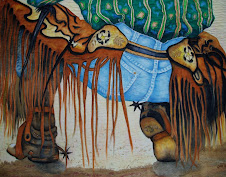There may be many ways to do this. This one works well for me so here goes. If one notes that many art quilters CROP their finished quilted work, it makes sense to consider these early steps as key.
There are 6 examples... 5 steps
( Steps one thru three top row left to right)
Steps four and five..bottom row left and middle
Finished Sample.. bottom row right.
STEP ONE.. Identifying The Edge.
There are actually 2 related steps and this post does assume the quilt is already blocked and flat. My blocking method is addressed in last weeks postings so take a peak at that if needed.
A. measure carefully and decide/mark the intended quilt edge. I used a sew-line white chalk pencil.
B. calls for a straight line stitch all around the perimeter right atop the chalk line.
In this example, I stitched only part of the way around so you could easily see the stitch line in relation to the marked line. (click on photos to enlarge) Thread Color Disclaimer : For demonstration purposes, I am using a contrasting thread so it is easy to see. In reality, I normally (where possible ) choose thread color close to matching what I'm stitching atop. In truth... I sometimes on this step only use monofilament or 100 wt invisafil as both are so very thin. I'll be stitching more than once around the quilt throughout the 5 steps so you'll perhaps appreciate why I normally might use such a thin thread.
The purpose of this stitch is two-fold.. to know where to trim and to secure quilted thread that extends beyond the edge/ultimate cut line. In the pics below, I've stopped short of stitching all the way around so you could see I am stitching directly atop markings. This will make more sense in step two pics.
STEP TWO: Trimming beyond the outside edge
is pretty simple but highly important. Using a rotary cutter, trim just to the outside of the step one stitch line. The straight line stitch from the previous step will now hold the 'cut' ends of quilting threads til we get through the additional steps. Failure to 'hold' down the loose ends of thread could present a messy finish. Notice in the second photo closeup below there is barely a hair-width distance from the stitched line to the cut edge.
STEP THREE: Adding Facing Fabric
I add a 1 3/4" border (really facing) to a finished quilt seaming at about 1/8" from edge. I didn't completely finish the 4th edge for your preview. Click on photos for closeup. In the second photo closeup below.. you may note this steps stitch line is barely inside the step one stitch line.
STEP FOUR Stitch at facings edge and stitch /turn under outer edges
Like step one.. these step has 2 parts.
A.Once Step 3 is finished, I press the outer border flat, then begin a third stitch line that goes through the blue fabric and also through the sliver of batting in that 1/8" seam from from step three. I use the inside edge of the left side of my 1/4" pressure foot to run directly along the edge of the 'ditch' as I stitch.
B. Turn under outer edges of facing approx. 1/4 inch and stitch from right side.
Several views following ending with the backside view.
STEP FIVE: The handwork finish
This step likewise has 2 parts...
A. First fold the directly opposite sides of the facing to the back side and hand stitch as you would a traditional binding. (NOTE: IF you have an extremely stiff quilt edge resulting from very heavy quilting.. you may need to dampen, roll to back, and pin edges til dry when they'll become more easily managed.) Your hand stitching appears only on the quilted back.. and stops short of the outer edges that are facing fabric only. You see below two sides already turned to the back and stitched. At the top outer left and right... there are fabric sample pieces of what one could (to minimize bulk) "CUT out" the loose edges of the sides just turned and stitched.
This second pic may give you a better idea how to trim excess bulk from the corners.
THE END RESULT:
Overall.. a nice clean knife edge facing.
A look from the side edge shows a clean looking fold atop the back facing. Remember... in a non demonstration effort, the lime green thread would likely have been blue like the backing fabric.
HAPPY QUILTING ALL!























No comments:
Post a Comment